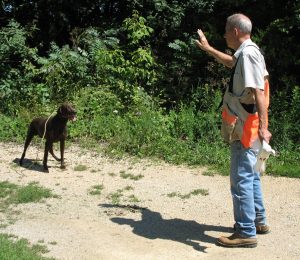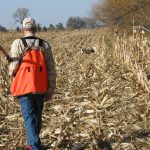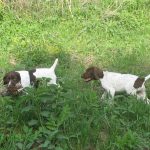POINTING DOG POINTERS: Thinking Outside the Box
by Bob and Jody Iler
Most pointing dog pro trainers use a structured training program that provides a good foundational start. Later on, though, other problems can arise that need solutions that are found by “thinking outside the box.” Musicians, contractors, tradespeople and many other folks – including pro trainers – often have to improvise, depending on the situation. You too, as a dog trainer, can adapt your program to your dog’s special needs or to issues that may come up as your training progresses.
Let’s take a look at some examples to get you thinking outside the box when you have a problem with your dog.
Buddy’s Collared Enthusiasm
Buddy, a young German shorthair, came to us with too much e-collar training. In the field, he worked at close range – even heeling at times – and seemed to lack interest in birds. He had an excellent pedigree from field trial and hunting bloodlines, so we knew he had what it takes.
After some brainstorming, our solution was to remove any training pressure and make everything pertaining to birds and field work fun for Buddy. By improvising – thinking outside the box – we let this young dog have his head. Soon he was happily chasing the flyaway birds. With lots of sweet talk and encouragement in the field, he ranged out and became more independent, focused on finding the birds. Within a month, Buddy’s pointing, bird-finding ability, and zest for hunting were restored. By getting him bird crazy and not worrying about advanced training, we changed the whole attitude of this seven-month-old pup.
With a little readjustment of his training methods, Buddy’s owner kept this good thing going. He went on to shoot birds over Buddy in his first season and the pup became an excellent hunting dog. In time, Buddy evolved into a natural retriever as well and sparkled in the field. Buddy’s story illustrates the important fact that using an e-collar too soon on a young dog can create unnecessary problems.
Murphy’s Rush
Murphy, a two-year-old Vizsla, was flash pointing and immediately jumping in on birds. His owner never got close enough to get a shot and was extremely frustrated. Thinking outside the box, we realized that he had never developed a solid whoa on Murphy when the dog was younger. He had also let Murphy run without control in the field and even catch birds occasionally. The checkcord was a minimal part of Murphy’s foundation training, discontinued way too soon. Using the checkcord on pointed birds and firmly restraining Murphy at the flush helped to teach the dog to stand his birds. Without the checkcord however, it was still tempting for Murphy to jump in.
So, we worked next on Murphy’s nonexistent whoa. Starting in the yard, we taught him the whoa command, eventually making him remain still as we walked around and away from him. Once Murphy understood what we wanted and was doing well, we carried a bird in our vest and released the flyaway bird while restraining him on the whoa. Soon he learned to remain staunchly on a whoa as we released birds during his training practice. This training is a precursor to being taught to be steady to wing and worked very well. Getting Murphy out on wild birds also taught him to be cautious and hold point, because he learned that if he jumped in the bird would fly away.
Gun-Shy Heidi
Heidi was a young German wirehair with lots of innate potential. She hunted, pointed, and retrieved by the time she was a year old, on her way to becoming a great started dog. On one early first-season hunt, her owner brought two of his buddies along. A couple pheasants flushed in an area away from where Heidi was hunting, and the buddies both unloaded on the birds. Heidi, spooked, ran back to the truck and hid underneath. Her owner had ignored our advice to hunt his dog alone at first and to keep shots to a minimum, only shooting at a bird his dog was working. Now he had a gun-nervous, or maybe even gun-shy dog.
Bringing Heidi back to our kennel, he asked us to help. Taking stock of the situation, we tried to improvise a solution – thinking outside the box. Heidi loved birds – a crucial factor in “fixing” a gun-shy dog. Away went the guns, period. Next, we needed to get Heidi’s enthusiasm for hunting back by getting her consistently into birds, letting her chase and have fun. This rehab process can take weeks, even months, and unfortunately, doesn’t always work. As Heidi’s drive and confidence returned, we started gently clapping a pair of 2 x 4 blocks together as she chased a flushed bird. Next, we tried a pop gun, waiting until she was a good distance away. After that came the 22 caliber, 32 blank gun, 410 and 20 gauge, in that order, and always a good distance away from Heidi. As we graduated to each louder gun, we watched closely for any reaction from Heidi. If, at any point, she noticed the noise, looked over her shoulder, or stopped in mid-chase, that was our signal to slow down, back up, and take our time.
Sally’s False Points
Sally, a young English setter, pointed staunchly and often, but never seemed to produce any birds. During our discussion with her owner, we asked if the pheasants he worked her on were possibly running out on her. We also asked about his training methods; If he was cautioning Sally too much as she hunted or praised her often while on point, he might be causing the problem or making it worse. He told us that he’d been very vocal on his whoa command and cautioned Sally when she started to show point.
Thinking outside the box, we explained that if he knew for certain that there was no bird there when his pup started to point, he should urge her onward, saying “OK” or “All right” or giving a similar command to keep her moving. Ignoring Sally and continuing forward so she wants to catch up to him should also help. When he plants his training birds, we advised him to make sure he knows exactly where those birds are. Hopefully Sally is hunting with her head high, taking in air scent rather than ground scent.
Again, praising the dog that false points can encourage the problem.
Think Outside the Box
These examples only scratch the surface of the different problems that can come up with your hunting buddy. The structured or “canned” program of training only provides guidelines for the average dog. Each pup is an individual! It’s important to observe him as you train, watching for what he’s trying to tell you as he develops into your hunting partner. Thinking outside the box – improvising your training geared to your special pup – will often provide the key to success.
Pointing Dog Pointers features monthly training tips by Bob and Jody Iler, who own Green Valley Kennels in Dubuque, Iowa. Bob and Jody have trained pointing dogs for over 35 years and have written many articles for Pointing Dog Journal.







